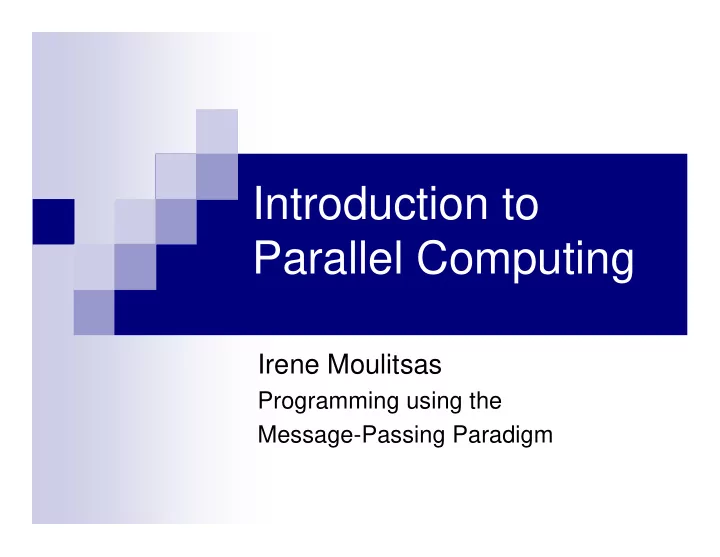

Introduction to Parallel Computing Irene Moulitsas Programming using the Message-Passing Paradigm
MPI Background � MPI : Message Passing Interface � Began in Supercomputing ’92 � Vendors � IBM, Intel, Cray � Library writers � PVM � Application specialists � National Laboratories, Universities
Why MPI ? � One of the oldest libraries � Wide-spread adoption. Portable. � Minimal requirements on the underlying hardware � Explicit parallelization � Intellectually demanding � Achieves high performance � Scales to large number of processors
MPI Programming Structure � Asynchronous � Hard to reason � Non-deterministic behavior � Loosely synchronous � Synchronize to perform interactions � Easier to reason � SPMD � S ingle P rogram M ultiple D ata
MPI Features � Communicator Information � Point to Point communication � Collective Communication � Topology Support � Error Handling
Six Golden MPI Functions � MPI is 125 functions � MPI has 6 most used functions
MPI Functions: Initialization � Must be called by all processes � MPI_SUCCESS � “mpi.h”
MPI Functions: Communicator � MPI_Comm � MPI_COMM_WORLD
Hello World !
Hello World ! (correct)
MPI Functions: Send, Recv � source � MPI_ANY_SOURCE � MPI_Status � MPI_SOURCE � MPI_TAG � MPI_ERROR
MPI Functions: Datatypes
Send/Receive Examples
Blocking Non-Buffered Communication
Send/Receive Examples
Blocking Buffered Communication
Send/Receive Examples
MPI Functions: SendRecv
MPI Functions: ISend, IRecv � Non-blocking � MPI_Request
MPI Functions: Test, Wait � MPI_Test tests if operation finished. � MPI_Wait blocks until operation is finished.
Non-Blocking Non-Buffered Communication
Example
Example
Example
MPI Functions: Synchronization
Collective Communications � One-to-All Broadcast � All-to-One Reduction � All-to-All Broadcast & Reduction � All-Reduce & Prefix-Sum � Scatter and Gather � All-to-All Personalized
MPI Functions: Broadcast
MPI Functions: Scatter & Gather
MPI Functions: All Gather
MPI Functions: All-to-All Personalized
MPI Functions: Reduction
MPI Functions: Operations
MPI Functions: All-reduce � Same as MPI_Reduce, but all processes receive the result of MPI_Op operation.
MPI Functions: Prefix Scan
MPI Names
MPI Functions: Topology
Performance Evaluation � Elapsed (wall-clock) time
Matrix/Vector Multiply
Recommend
More recommend